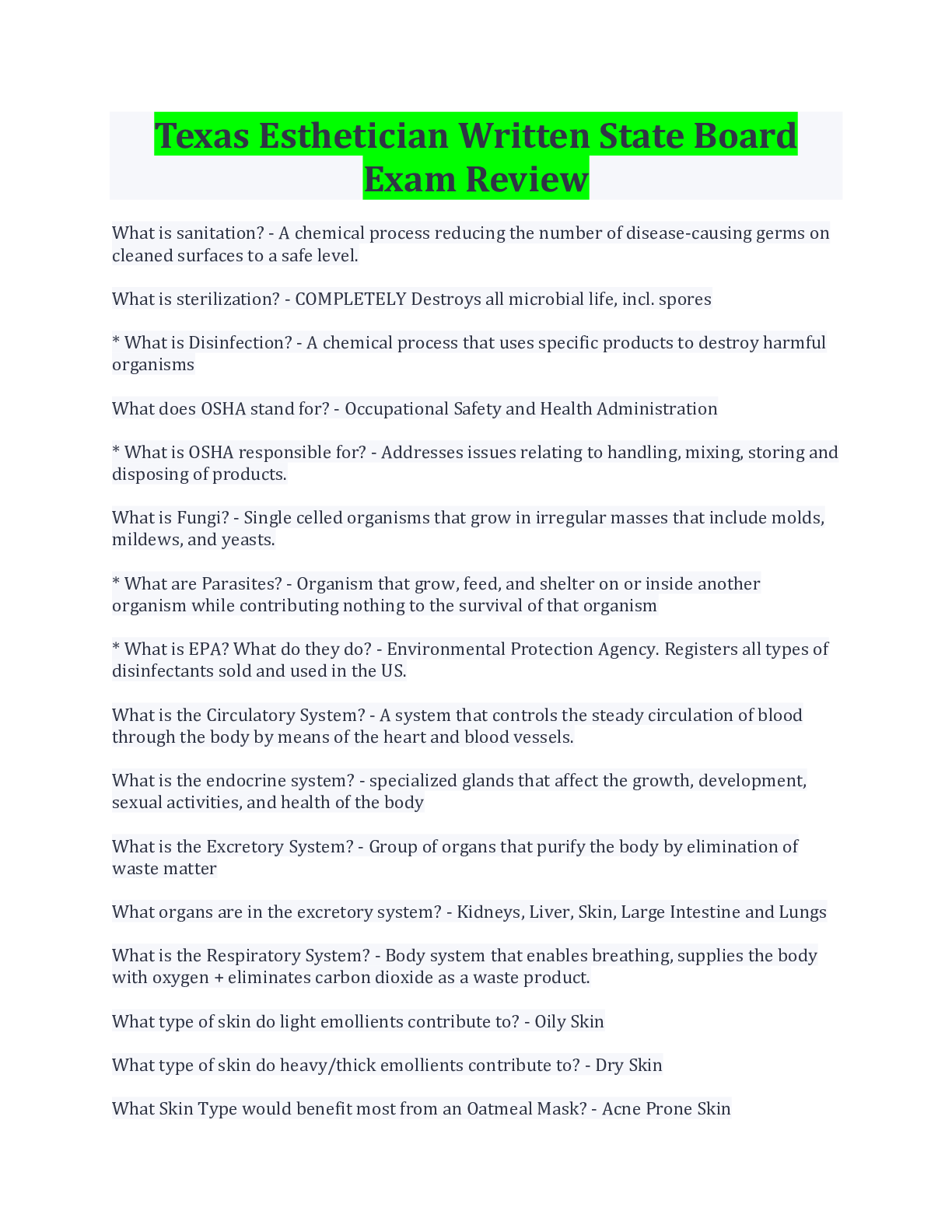*NURSING > EXAM > APhA immunization & IMZ PreTest 51 Questions with Verified Answers,100% CORRECT (All)
APhA immunization & IMZ PreTest 51 Questions with Verified Answers,100% CORRECT
Document Content and Description Below
APhA immunization & IMZ PreTest 51 Questions with Verified Answers Which of the following vaccines may be administered to boys and young men aged 9 through 26 years to reduce the likelihood of ac... quiring genital warts? - CORRECT ANSWER 9vHPV -provides protection against two of the strains known to cause genital warts. -may be given to both males and females ages 9 through 26 years and is routinely recommended at ages 11 or 12 years. A history of anaphylaxis caused by gelatin would be a contraindication to receiving which vaccines? - CORRECT ANSWER live attenuated influenza vaccine (Flumist), MMR, MMRV, rabies (RabAvert), typhoid (Vivotif Ty21a), varicella, yellow fever, and zoster (Zostavax) Even though state laws may have specific mandates, how long should pharmacists maintain records of immunizations? - CORRECT ANSWER patient's lifetime What is the type of immunity that occurs when a pregnant woman is vaccinated with Tdap to protect the infant from pertussis after birth? - CORRECT ANSWER Passive immunity happens when antibodies are provided from another source, such as or upon receipt of blood products or immunoglobulin when maternal antibodies are transferred to the fetus. This is the reason Tdap is given with every pregnancy—the maternal antibodies passed to the fetus protect the newborn from pertussis. Upon giving a VIS to a patient who is to receive a vaccine cover under the National Childhood Vaccine Injury Act, what must be documented? - CORRECT ANSWER patient name, date vaccine was administered, vaccine mfr & LOT #, name/address/title of person administering vaccine, date printed on VIS, date VIS was given to vaccine recipient or legal representative What is the most common complication of pertussis? - CORRECT ANSWER pneumonia What are the 3 screening strategies to identify people at risk for vaccine-preventable disease? - CORRECT ANSWER 1. diagnosis-based screening. 2. procedure-based screening. 3. occurrence-based screening (i.e. hospital admission, clinical visit). Which of the following is most likely to result in an influenza pandemic? - CORRECT ANSWER antigenic shift in which one or both of the surface antigens on the influenza A virus change. A new strain is created that can result in widespread infection. Antigenic drift occurs continuously and leads to minor changes in the structure of the virus, but does not result in new strains. At what point during pregnancy is it recommended to administer influenza vaccine? - CORRECT ANSWER any time Which vaccines are live attenuated vaccines? - CORRECT ANSWER cholera, herpes zoster, live attenuated influenza vaccine (LAIV), MMR, MMRV, rotavirus, tuberculosis (BCG), typhoid (Ty21a), vaccinia (smallpox), varicella, and yellow fever. If pharmacists are called upon to assist with vaccination efforts following a natural disaster, which vaccine is likely to be needed by many of the victims? - CORRECT ANSWER Td or Tdap If a patient is a candidate for revaccination with PPSV23, what is the ACIP-recommended interval between doses of this vaccine? - CORRECT ANSWER 5 years [Individuals at high-risk for pneumococcal disease may require one to three doses of PPSV23, depending on age and condition. When multiple doses are required, the interval between doses should be 5 years. For example, individuals under the age of 65 who are immunocompromised or have asplenia should receive two doses of PPSV23 five years apart. If the second dose was administered prior to age 65, then a third dose would be given after the individual turns 65 (and five years after the previous dose).] Prior to the introduction of a vaccine, what was the leading cause of bacterial meningitis in children younger than 5 years of age? - CORRECT ANSWER H. influenzae type b (Hib) If a patient received the first dose of HepB but did not return for the remaining doses in the series, under what circumstances should the HepB series be restarted? - CORRECT ANSWER If patients fall behind with vaccinations given in a multi-dose series, it usually is not necessary to start the series over; oral typhoid is the one exception. Increasing the interval between doses of a multi-dose vaccine series does not diminish the ultimate effectiveness of the vaccine, but it does delay protection for the patient. David is a healthy 5-year-old boy who is scheduled to see his pediatrician for a checkup in July prior to starting kindergarten. David's immunization record reveals that he has received the following vaccines: 3 doses of HepB 4 doses of PCV13 2 doses of HepA 3 doses of IPV 2 doses of rotavirus 1 dose of MMRV 4 doses of DTaP 4 doses of Hib Which vaccines should David receive at this visit? - CORRECT ANSWER David will need his 5th dose of DTaP, 4th dose of IPV, 2nd dose of MMR, and 2nd dose of varicella. His PCV13, Hib, hepatitis A and B series are complete. Depending on the rotavirus vaccine used, two doses may have completed the series. Regardless, David is too old to receive any additional rotavirus vaccine doses. He does not require the meningococcal vaccine (MCV4) until he is 11 to 12 years of age. Because he needs both MMR and varicella, he may receive the MMRV combination vaccine again. For a patient who needs to receive IIV and HZV, which of the following best describes appropriate administration of these vaccines? - CORRECT ANSWER IIV is the inactivated influenza vaccine and HZV is the live, attenuated herpes zoster vaccine. Inactivated vaccines do not interfere with the immune response to other vaccines, live or inactivated. There is no need to observe any minimum interval between doses of two different inactivated vaccines, nor between combinations of inactivated and live vaccines. The concern is when two live vaccines are not administered at the same clinic visit. If two live vaccines are not given simultaneously, at least 4 weeks must pass before giving the other live vaccine. In the event that a young child is fussy following the receipt of a vaccine, pharmacists should advise parents to: - CORRECT ANSWER Young children may experience drowsiness, fretfulness, or poor appetite following vaccination. Parents should be advised to plan quiet activities and comfort their children as needed. Children's formulations of acetaminophen or ibuprofen can be used to relieve local discomfort, if needed. Aspirin is not recommended for use in children. If more serious adverse reactions occur, parents should be instructed to seek emergency care and to follow up with the pediatrician as necessary. HealthMap Vaccine Finder is a free online tool that allows pharmacists to: - CORRECT ANSWER Pharmacists also can list their vaccine service with the HealthMap Vaccine Finder, which is a free marketing tool. To participate in HealthMap Vaccine Finder, vaccine providers create an account at flushot.healthmap.org/admin/signup and enter information on their immunization services regarding several kinds of influenza vaccines and other adult vaccines. People wanting to be vaccinated can go to the website, flushot.healthmap.org, and enter their zip code to locate vaccine providers in their area. Which vaccine does ACIP recommend for all college freshmen, aged 21 years or younger, living in dormitories, who have not been previously vaccinated? - CORRECT ANSWER Routine vaccination with the quadrivalent meningococcal conjugate vaccine (MenACWY or MCV4) is one dose at ages 11 to 12 years and a booster dose at age 16 years. A first-year college student aged 21 years or younger living in residential housing who has not been previously vaccinated with MCV4 is considered high-risk for meningococcal disease. One dose should be administered. Living in dormitories on a college campus is not considered a risk factor for pneumococcal disease, HPV, or varicella. For which age group is the adjuvanted inactivated influenza vaccine approved? - CORRECT ANSWER 65 years and older All Medicare Part B enrollees are covered for which vaccines? - CORRECT ANSWER pneumococcal vaccines and influenza (hepB is covered for only specific high-risk pts & Td/tdap, & herpes zoster is covered under PartD) Herd immunity refers to which of the following situations? - CORRECT ANSWER There are instances in which some individuals are not able to be vaccinated. For example, infants younger than 2 months of age are too you to receive DTaP and a child with a compromised immune system would not likely receive MMR. It is important to vaccinate those in the community who can receive the vaccine to avoid outbreaks and the transmission of disease to those unvaccinated. Alex is a 32-year-old man who is scheduled to travel to a country where hepatitis A is endemic. He leaves in 3 weeks and will be gone a month. He received his first dose of hepatitis A vaccine today. Alex should be counseled to return for his second dose of hepatitis A vaccine: - CORRECT ANSWER Adults needing protection from the hepatitis A virus should receive a two-dose series. The second dose should be given at least 6 months after the first dose. The presence of fever, diffuse maculopapular rash, and Koplik spots are characteristic of which of the following diseases? - CORRECT ANSWER measles. The classic symptoms of measles include fever, cough, coryza (runny nose), conjunctivitis, Koplik spots (a bluish-white rash on mucous membranes, especially the mouth), followed by the development of a maculopapular rash approximately 14 days after exposure. Individuals infected with mumps may not have symptoms. Others may have nonspecific symptoms, such as headache, fever, myalgia, and malaise. About 30% to 40% of individuals may experience inflammation of the parotid glands. Rubella symptoms tend to be relatively mild and may present as a maculopapular rash that occurs approximately 14 days after exposure. Others may experience arthritis and arthralgia. Varicella presents as a generalized vesicular rash HPV vaccine is recommended for which of the following individuals? - CORRECT ANSWER males & females aged 9-26 Name the vaccine-preventable disease that may be contracted by unimmunized children from adults serving as reservoirs for the disease, which causes a paroxysmal cough and potentially can result in pneumonia, seizures, encephalopathy, hypoxia, and death. - CORRECT ANSWER Bordetella pertussis is highly contagious and symptoms progress through stages over several weeks. It begins with a catarrhal stage that lasts approximately 1 to 2 weeks with symptoms similar to the common cold: mild cough, runny nose, sneezing, and fever. This stage is followed by a paroxysmal cough stage, which can last from 1 to 6 weeks. During this stage, the patient will experience paroxysms, which are coughing attacks characterized by numerous, rapid coughs. During the coughing attacks, a high-pitched "whooping" sound often can be heard, which is why pertussis is often referred to as whooping cough. Young children are most prone to complications, which include pneumonia, seizures, encephalopathy, hypoxia, and death. Adolescents and adults tend to present with more mild symptoms and serve as reservoirs capable of transmitting pertussis to young children who have not yet been vaccinated. Jackie is a 34-year-old woman who received an influenza vaccine from you today. She wants to know how long it will take for the vaccine to begin working to protect her from getting the flu. What would be the most appropriate response to this patient? - CORRECT ANSWER 14 days A 69 year-old man received Td vaccination 4 years ago. He is preparing to travel to see his newborn granddaughter next month. Which of the following vaccines containing tetanus, diphtheria, and/or pertussis would be most appropriate for him? - CORRECT ANSWER According the the ACIP recommendations, all adults who have not received tetanus and diphtheria toxoids and acellular pertussis vaccine (Tdap) or for whom pertussis vaccination status is unknown should receive 1 dose of Tdap followed by a tetanus and diphtheria toxoids (Td) booster every 10 years. Tdap should be administered regardless of when a tetanus or diphtheria toxoid-containing vaccine was last received. Which viruses are associated with the development of cancer? - CORRECT ANSWER HPV, HepB In 2014, which vaccination rate was lowest among adolescents 13 through 17 years of age? - CORRECT ANSWER In 2014, the vaccination rate for 3 doses of HPV in females and males ages 13 through 17 years was 40% and 22%, respectively. This was drastically lower than other vaccines routinely recommended for adolescents. The rate of meningococcal (MenACWY) vaccination in this age group was 79%. The rate of Tdap vaccination was 88%. The rate of at least 2 doses of MMR vaccination was 91%. How often are the Healthy People targets for vaccination rates updated? - CORRECT ANSWER Healthy People, which is a component of the U.S. Department of Health and Human Services, provides measurable objectives and goals for improving the health of Americans every 10 years. The objectives are based on science and include targets for immunizations and infectious disease prevention Which patients would be a candidate for PPSV23? - CORRECT ANSWER The23-valent pneumococcal polysaccharide vaccine is recommended for all adults age 65 years an older and those considered high-risk for pneumococcal disease. These individuals are immunocompromised, those with cerebrospinal fluid leak or cochlear implants, those with diabetes, chronic heart disease, chronic lung disease, chronic liver disease, and alcoholism, and those ages 19 through 64 with asthma or who smoke cigarettes. Children with asthma would only be candidates for PPSV23 if they are treated with high-dose corticosteroids. Because this is a polysaccharide vaccine, it is not effective in children less than 2 years of age. Pregnancy is not considered a risk factor for pneumococcal disease. Which vaccines are recommended for infants to receive within 24 hours of birth? - CORRECT ANSWER The only vaccine routinely recommended to be given at birth is the hepatitis B vaccine. This dose, when given within 24 hours of birth, is critical for reducing maternal transmission of the virus. Following the first dose, two additional doses are needed (one at age one to two months and the third dose at ages 6 through 18 months). A health care provider who has not been vaccinated against hepatitis B is stuck by a contaminated needle after administering an immunization to a hepatitis B-positive patient. In addition to hepatitis B vaccine, the health care provider also should receive hepatitis B Immunoglobulin (HBIG) as postexposure prophylaxis because the HBIG provides: - CORRECT ANSWER Giving both the hepatitis B vaccine and hepatitis B immunoglobulin (HBIG) allows for active and passive immunity. Active immunity occurs when the antigen from the vaccine triggers the immune system to respond. The vaccine will provide long-term protection but it takes the body about two weeks to develop immunity. Passive immunity happens when antibodies are provided from another source, such as immunoglobulin. Passive immunity is short-live, but it provides protection right away Which disease is characterized by the development of a membrane on the tonsils, pharynx, or larynx, leading to respiratory obstruction? - CORRECT ANSWER diphtheria Emily is a 16-year-old high-school student with no chronic medical conditions. Emily's immunization record shows that she completed the primary series for IPV, HepA, Hib, DTaP, and MMR, and she had a physician-diagnosed case of chickenpox at 2 years of age. Which of the following would be the most appropriate recommendation for her today? - CORRECT ANSWER Emily was supposed to receive Tdap, MCV4, and HPV at ages 11 to 12. It also appears she did not receive her hepatitis B vaccines as an infant. Emily will need to get caught up on these four vaccines. Since influenza vaccine is universally recommended on an annual basis, she should receive that as well if it is during influenza season. We would refer to the catch-up schedule for dosing interval guidance. Arthus reactions, which are exaggerated local reactions that can occur if a patient is vaccinated too frequently, are most commonly reported after which vaccine? - CORRECT ANSWER tetanus and diphtheria toxoids-containing vaccines Which of the following diseases has been successfully eradicated worldwide through vaccination efforts? - CORRECT ANSWER Smallpox In 2014, which vaccination rate was lowest among adolescents 13 through 17 years of age? - CORRECT ANSWER HPV What is meant by the term "immunization neighborhood"? - CORRECT ANSWER Immunization stakeholders collaborate to meet community immunization needs. Which of the following statements is true regarding how vaccines evoke an immune response? - CORRECT ANSWER The antigen in the vaccine activates B cells, which produce antigen-specific antibodies and memory cells. Jackie is a 34-year-old woman who received an influenza vaccine from you today. She wants to know how long it will take for the vaccine to begin working to protect her from getting the flu. What would be the most appropriate response to this patient? - CORRECT ANSWER 14 days A health care provider who has not been vaccinated against hepatitis B is stuck by a contaminated needle after administering an immunization to a hepatitis B-positive patient. In addition to hepatitis B vaccine, the health care provider also should receive hepatitis B Immunoglobulin (HBIG) as postexposure prophylaxis because the HBIG provides: - CORRECT ANSWER Prompt immunity Which of the following tetanus booster vaccines would be most appropriate for administration to a 12-year-old boy who has completed a primary series with DTaP and has no known allergies? - CORRECT ANSWER Tdap Arthus reactions, which are exaggerated local reactions that can occur if a patient is vaccinated too frequently, are most commonly reported after which vaccine? - CORRECT ANSWER Tetanus and diphtheria toxoid-containing vaccines. According to the Advisory Committee on Immunization Practices (ACIP), which of the following would be considered adequate evidence of immunity to varicella, indicating that administration of varicella vaccine is unnecessary? - CORRECT ANSWER Diagnosis of chickenpox by a health care provider. If a patient received the first dose of HepB but did not return for the remaining doses in the series, under what circumstances should the HepB series be restarted? - CORRECT ANSWER The series should not be restarted; resume the series where it was interrupted. For a patient who needs to receive IIV and HZV, which of the following best describes appropriate administration of these vaccines? - CORRECT ANSWER Administer these 2 vaccines at the same visit. Which of the following is recognized by sociologists as a factor in a patient's decision whether to be vaccinated? - CORRECT ANSWER Influence of a health care provider. Which of the following statements about pharmacy-based vaccination programs is true? - CORRECT ANSWER Administratively, billing for vaccines covered by Medicare Part D may be easier for pharmacists than physicians. Which of the following is a requirement of the Occupational Safety and Health Administration's (OSHA's) Bloodborne Pathogens Standard? - CORRECT ANSWER Health care providers must use safety devices when administering injectable vaccines. [Show More]
Last updated: 7 months ago
Preview 1 out of 9 pages
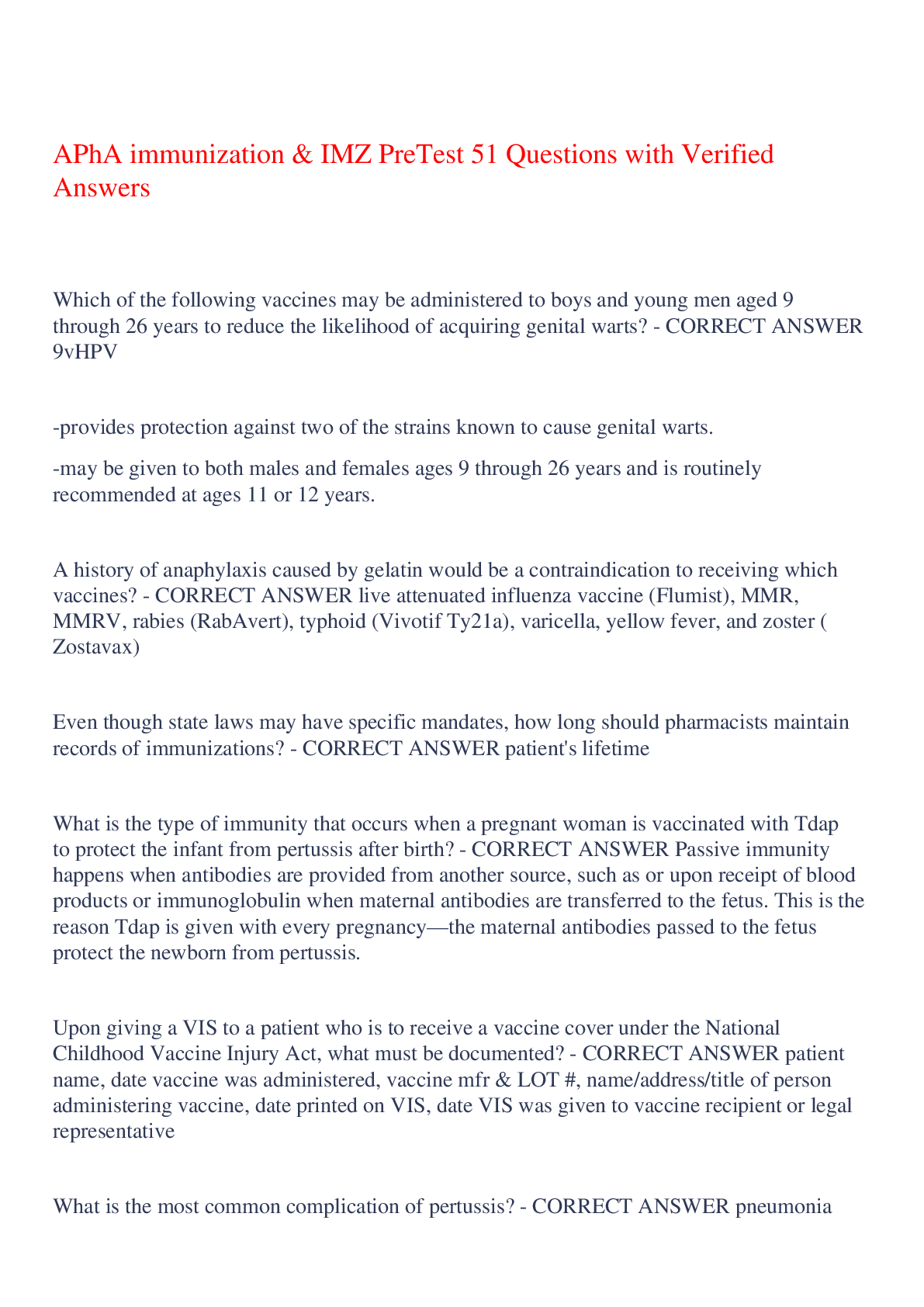
Buy this document to get the full access instantly
Instant Download Access after purchase
Add to cartInstant download
We Accept:

Reviews( 0 )
$9.00
Document information
Connected school, study & course
About the document
Uploaded On
Nov 02, 2023
Number of pages
9
Written in
Additional information
This document has been written for:
Uploaded
Nov 02, 2023
Downloads
0
Views
355














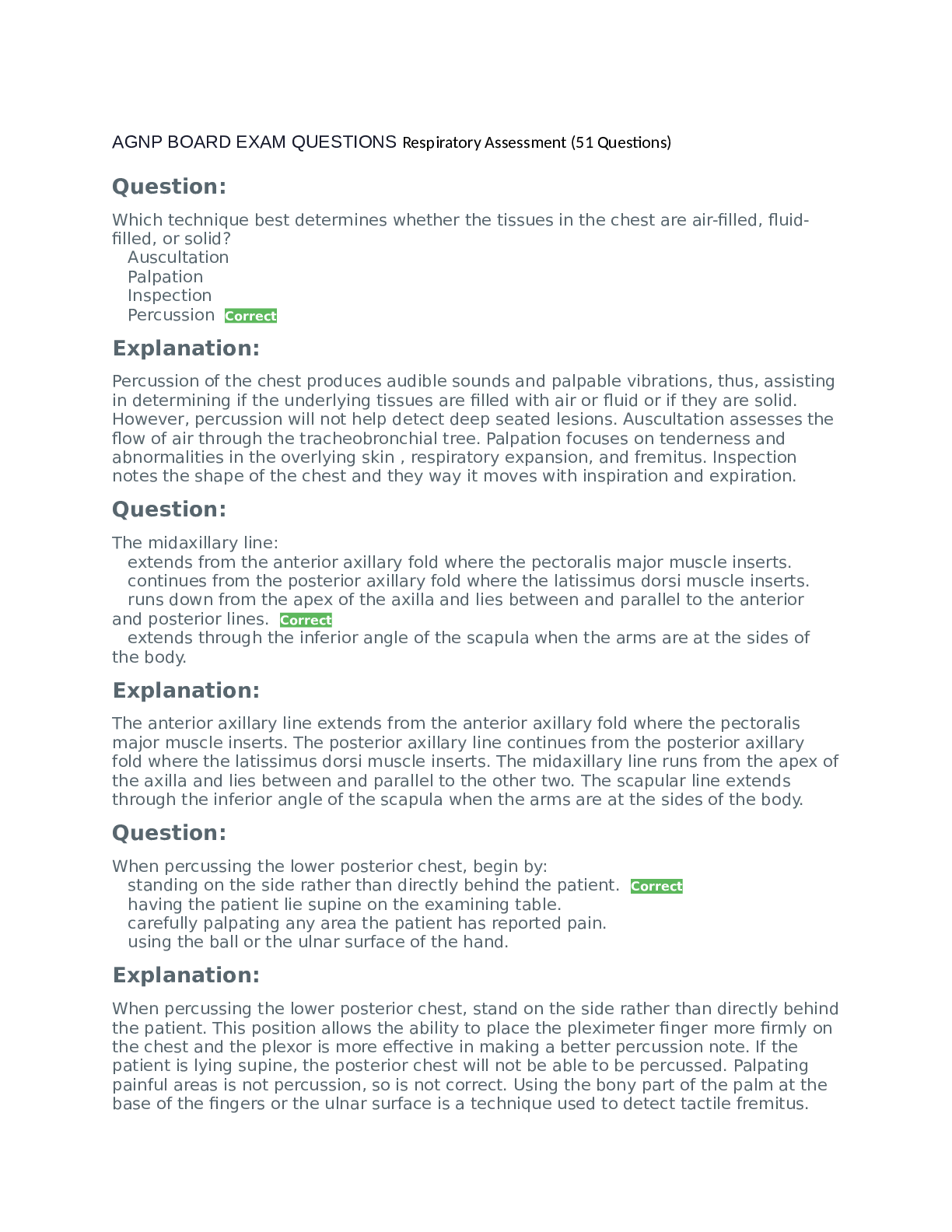
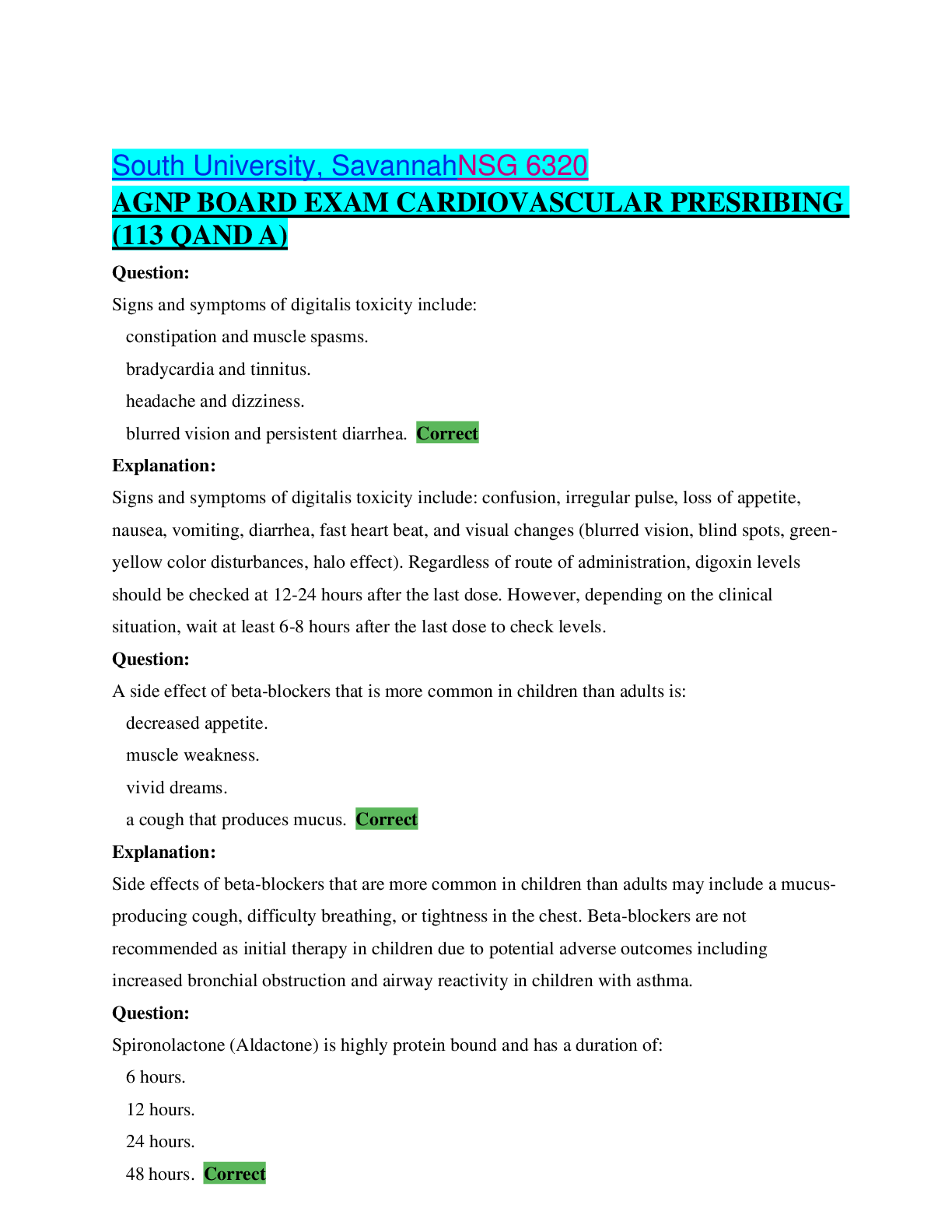

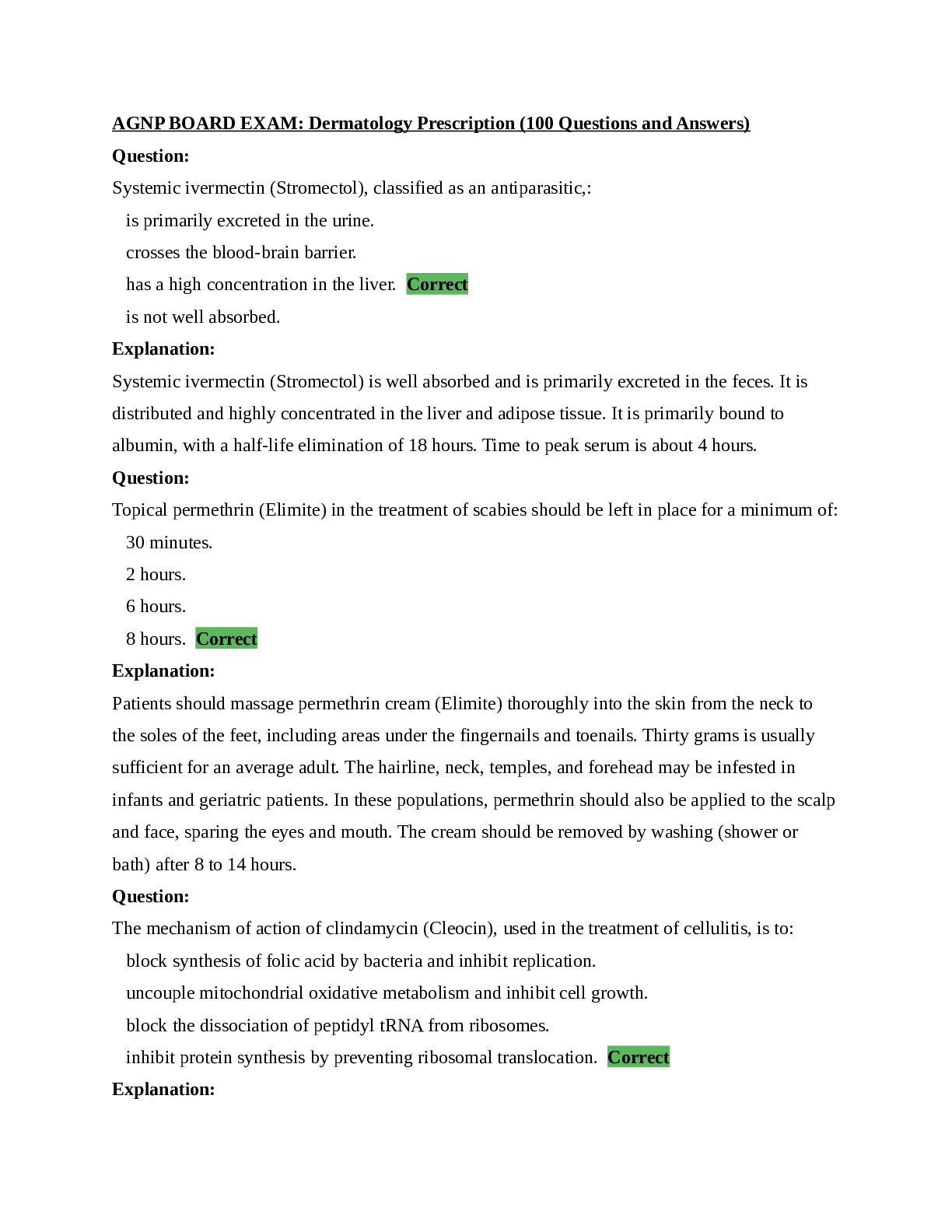

.png)


